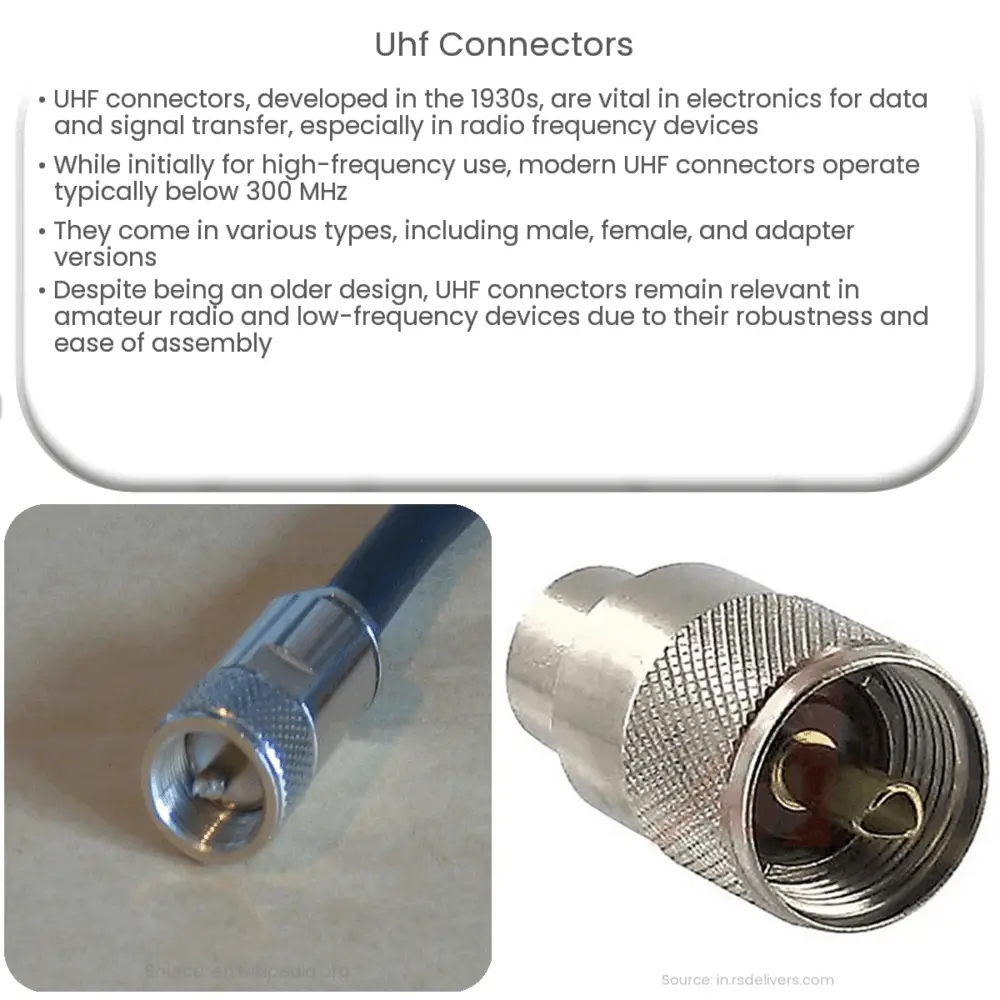Explore the comprehensive guide on UHF connectors: origins, types, applications, advantages, limitations, installation, and their future in the electronics industry.

Introduction to UHF Connectors
The world of electronics and communication relies heavily on various connectors to ensure data and signal transfer. One of the most vital components used is the Ultra-High Frequency (UHF) connector. UHF connectors, also known as Amphenol connectors, are popularly utilized in devices dealing with radio frequency (RF) applications.
Origins and Specifications
Designed in the 1930s for use in the radio industry, UHF connectors have gained their name due to their initial use in Ultra High Frequency applications. Although the name implies use for high-frequency connections, modern UHF connectors are more commonly used in applications of lower frequency, typically under 300 MHz.
The typical design of a UHF connector includes a threaded coupling, which ensures a secure connection even under significant movement or vibration. These connectors are typically impedance-mismatched and are not suited for high frequency or high precision applications.
Types of UHF Connectors
-
UHF Plug (Male): Also referred to as a PL-259, it’s the male version of the UHF connector. It is usually found on the ends of coaxial cables.
-
UHF Jack (Female): Known as the SO-239, the female connector is typically found on equipment such as radios and antennas.
-
UHF Adapter: These are used to connect two devices with incompatible connectors, or to change the gender of a connector.
Applications of UHF Connectors
Despite being an older design, UHF connectors remain relevant and useful in several applications. Initially used in military and industrial settings, they have found their way into various consumer electronics. Their rugged design and ease of assembly make them a popular choice for applications where precision isn’t a high priority.
Common uses include amateur radio, Citizens Band radio, and other low-frequency applications. In these contexts, the UHF connector’s durability and reliability are more important than their impedance matching capabilities.
Advantages and Disadvantages
-
Advantages: UHF connectors are inexpensive, easy to assemble, and quite robust. They can handle large amounts of power, and their threaded coupling provides a secure connection.
-
Disadvantages: Due to their impedance mismatch, UHF connectors are not suitable for high frequency or precision applications. Their size also makes them less desirable for modern compact devices.
Understanding the Limitations
It’s essential to understand that UHF connectors, while versatile and useful, have limitations. Their physical size and impedance mismatch mean they’re unsuitable for high-frequency applications above 300 MHz. For frequencies higher than this, connectors such as BNC or N-type would be a better choice.
How to Install UHF Connectors
-
Strip the cable: First, you will need to carefully strip away the outer insulation of the coaxial cable, exposing the shielded part of the wire.
-
Prepare the connector: Screw the back part of the connector onto the stripped cable.
-
Solder the connector: Push the wire through the connector and solder it in place. After the solder cools down, screw the connector’s back and front parts together.
Safety Tips
As with all electronic components, it’s crucial to handle UHF connectors safely. Always ensure the equipment is switched off before changing connectors to avoid the risk of electrical shock. Additionally, be careful when soldering connectors to avoid burning yourself or damaging the cable or connector.
Future of UHF Connectors
With technology consistently advancing, the demand for smaller, more precise connectors is growing. Yet, there is still a place for the humble UHF connector. Their robustness and ease of assembly make them a practical choice for various applications. They continue to be used extensively in areas such as ham radio, where precision isn’t the priority, but durability and ease of use are.
Conclusion
In conclusion, UHF connectors, despite being an older technology, have a significant place in today’s electronics and communication sectors. Their inherent advantages such as robustness, ease of assembly, and cost-effectiveness make them a staple in applications such as amateur radio and low-frequency devices. However, understanding their limitations is crucial when choosing the right connector for your needs. With the growing demand for precision and miniaturization, the UHF connector’s role may diminish in some areas, but their usefulness in specific applications ensures they will continue to have a place in the world of electronics.

